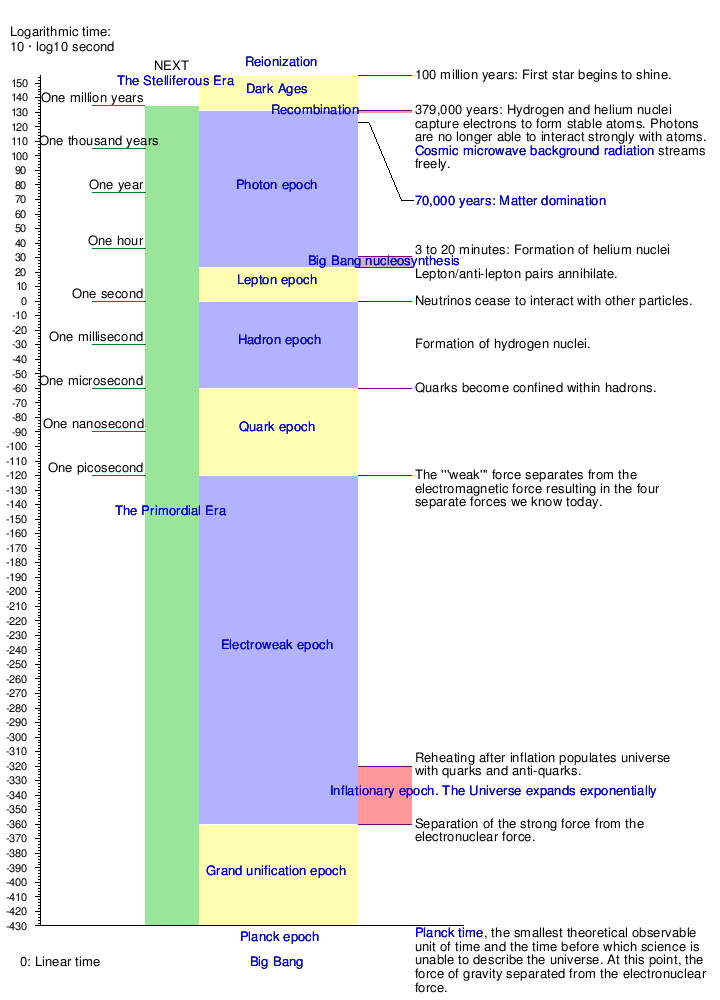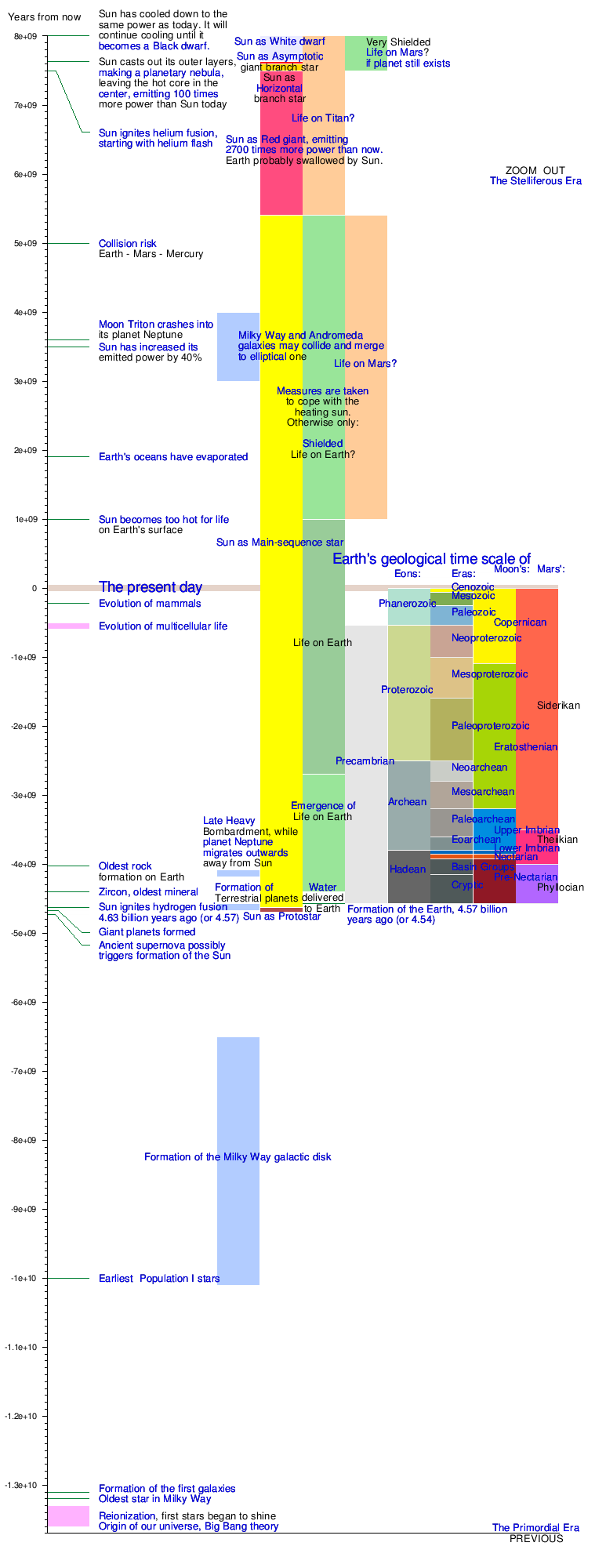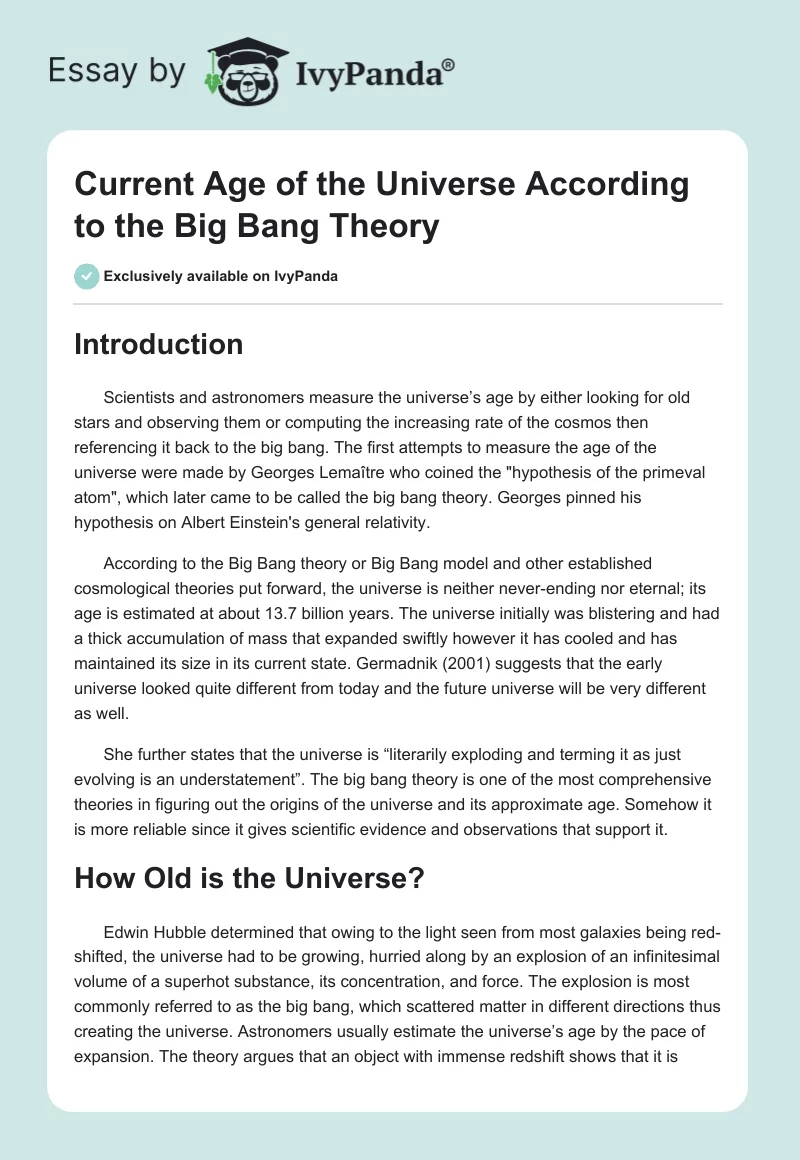Introduction
Scientists and astronomers measure the universe’s age by either looking for old stars and observing them or computing the increasing rate of the cosmos then referencing it back to the big bang. The first attempts to measure the age of the universe were made by Georges Lemaître who coined the “hypothesis of the primeval atom”, which later came to be called the big bang theory. Georges pinned his hypothesis on Albert Einstein’s general relativity.
According to the Big Bang theory or Big Bang model and other established cosmological theories put forward, the universe is neither never-ending nor eternal; its age is estimated at about 13.7 billion years. The universe initially was blistering and had a thick accumulation of mass that expanded swiftly however it has cooled and has maintained its size in its current state. Germadnik (2001) suggests that the early universe looked quite different from today and the future universe will be very different as well.
She further states that the universe is “literarily exploding and terming it as just evolving is an understatement”. The big bang theory is one of the most comprehensive theories in figuring out the origins of the universe and its approximate age. Somehow it is more reliable since it gives scientific evidence and observations that support it.
How Old is the Universe?
Edwin Hubble determined that owing to the light seen from most galaxies being red-shifted, the universe had to be growing, hurried along by an explosion of an infinitesimal volume of a superhot substance, its concentration, and force. The explosion is most commonly referred to as the big bang, which scattered matter in different directions thus creating the universe. Astronomers usually estimate the universe’s age by the pace of expansion. The theory argues that an object with immense redshift shows that it is moving farther and farther away and more redshift is pronounced in its light (Lanzerotti & National Research Council (U.S.), 2005, 45).
Scientists have approximated the age of the universe to be about 13.7 billion years old though there is no assurance about the astronomical observations. A simple response is that the universe is estimated to be 10 to 20 billion light-years in radius. This figure is arrived at by multiplying the speed of light with the estimation of the age of the universe. The logic for this assumption is rather clear-cut: we are capable of only making out to that expanse when the universe began, from which light might have reached us since.
Measuring Age of the Universe
The Oldest Stars
The life cycle of a star depends on its mass, and as a result stars with soaring mass are brilliant than those with fewer mass and rage rapidly all the way through their hydrogen fuel supply. For example, a star twice as large as the sun which has enough fuel to burn up at its core at its present intensity for roughly 9 billion years, can burn through its reserves for about 800 million years. A star that is half the size of the sun burns slowly through its reserves and can take 20 billion years to burn out completely. Scientists can calculate roughly how old stars maybe by observing their globular clusters. These are solid collections of around 1 million stars formed at the same time and they produce much softer light as compared to the sun (NASA Goddard space flight center 2010).
These two scenarios form the basis of how the universe’s age can be measured and estimated to a close enough figure. Stars within a cluster form a cosmic clock as their formation takes place at just about similar periods, while stars within the most matured globular clusters have stars less than 0.7 solar masses. Therefore some of the old globular clusters can be estimated to be about 11-18 billion years. 10 million-year-old cluster hydrogen stars have approximately 10 solar masses in size.
This implies that “hydrogen flaming stars cannot burn 1000 times brighter than the Sun” (Fox 2002, 249). Clusters 2 billion years old do not have hydrogen-burning stars larger than 2 solar masses. The ambiguity in this estimate is due to the complexity in determining precise distance to a globular cluster therefore, there is doubt in the intensity (and mass) of stars within a cluster.
Estimating Back to the Big Bang
This method is commonly used by cosmologists. It uses the “Hubble constant” to determine the universe’s age and estimate it back to the big bang. It is a measure of the current expansion rate and relies on the existing concentration and makeup of the universe (Singh 2005; Freedman 2004, 73). The Hubble constant states that the age of the universe has high-density matter; its age will be 2/3 (HO) but on the other hand, if it has less dense matter then its age will be more than 1/3 (HO) and the indirect age can be greater if the conjecture of general relativity is customized to comprise an astrophysical constant.
Recent Findings in Relation to the Age of the Universe
The universe could be older than we may think if recent findings are anything to go by. Recent reports and measurements show the galaxy to be as huge and similarly dense as elliptical galaxies found a lot closer to us. Together with fresh observations by a different team that found an incredibly compact and tremendously dense elliptical galaxy in the early Universe – the dilemma of how wholly developed galaxies exist alongside seemingly immature compact galaxies in the young universe continues to simmer. Scientists have recently discovered new properties some of which contradict prevailing theories and have observed two dozen new supernovae (Kupperberg 2005, 158).
These findings emerged when a team of scientists using NASA’s swift satellite were trying to capture ultraviolet and X-ray images of normal supernovae moving normally. The findings were presented at a “High Energy Astrophysics Division of the American Astronomical Society assembly by” head of the mission Stefan Immler of NASA Goddard Space Flight Center, Greenbelt. The report argued that it was possible to study inside hours to days the supernovae as opposed to before where there was a delay of days to weeks and clues are being found of how stars exploded (Trefil 2004, 67).
The team established facts to explain that an annihilated white dwarf star had been orbiting a red giant. This was observed from the SN 2005ke’s X-ray and ultraviolet light. This is the first Type Ia of supernova brilliant in ultraviolet than expected, monitored through X-ray wavelengths. Astronomers measure distances in the universe using Type Ia supernova since they have a known luminosity in their shine. This examination could possibly help scientists comprehend the origins and evolution of these supernovae, which is very vital to the study of cosmology and dark energy. The subsequent supernova Type II is the SN 2006bp, a central part disintegrates of an immense star once its fuel is depleted.
The team observed that a day after the explosion, X-rays were still present and that they were washed out within days. It implies that preceding supernova monitoring purely failed to observe them since X-ray observatories ignored star explosions for about a week. The team discovered that the X-rays gave direct information on the chemical content and immediate environs of the star. Burning gas that resulted from the blast in the star’s surrounding area was noted.
This was a surprise discovery because observation of the previous supernova purely missed them because X-ray observatories rarely observe explosions immediately and only pay attention to them a week after they take place. The implication of this is that the common thought that stars’ winds blow a cavity around stars before the explosion was not a practical observation (Fleisher 2006, 45).
Impact of Future Telescopes
The search for enhanced angular resolution consequently source detection and spectral resolution for extra information on source behavior has ever being ongoing since the first telescope was invented. The test of working in this complex energy range makes further demands on instrument developers than any other fields. It is expected that future telescopes will make use of more highly developed solid-state technology to prevail over some of these problems resulting to a provision of great, sensitive telescopes which will promote study of astronomy as an essential part of cosmological research.
The Hubble Space Telescope (HST), compared to standard ground telescopes can see much clearly and focus sharply at all wavelengths from the near-infrared to the ultraviolet. Its images are 5- 20 times sharper than standard grounds telescopes, whose vision is more often than not distorted by the atmosphere.
The extremely dark sky also helps the HST to see objects 10 times fainter than those seen with even the largest of ground telescopes (Kumar 2010, 48). Molding future telescopes on the Hubble will increase image intensity, sharpness and stable images. Each of these factors will signify progression for science as they would be much useful to the work of astronomers who depend on what they can observe in the universe so as to formulate their calculations and assumptions. This will result into the most reliable astronomical capability in the history of the universe and its study.
Future telescopes molded on the Hubble that are unmanned and orbit the space by use of robotics will be much advantageous to astronomers. NASA has been carrying out studies on whether to extend the scientific life of the Hubble through robotic servicing or to de-orbit it by 2013. Some of the advantages of future telescopes may include, astronomers will be able to look closely into the heart of galaxies to quantify orbital speeds of gases and stars close to their center due to high angular resolutions. Key information established will disclose a relationship between black hole mass and galaxy properties that might provide critical clues to how and why these holes formed.
Another advantage is that objects whose light has taken billions of years to get to us can be observed as they were some distant time in the past, therefore, showing the evolution of the universe, for example, the Hubble Ultradeep Field can infiltrate back more than 12 billion years to within 1 billion years of the Big Bang, baby galaxies can be seen still in their formation process (Seeds & Backman 2009, 243; The National Academic Press, 2010).
Conclusion
Obtaining an accurate figure of the age of the universe is almost impossible because of the several assumptions made by the models. Scientists and astronomers are constantly rechecking and replacing errors from prior models in order to achieve accurate results in their calculations and data. However, from the big bang model, the age of the universe (13.7 billion) is more or less an accurate figure to the particular error which represents the error in the type of instruments used to obtain this data.
Age can be measured in two different ways as mentioned above. The universe as we have seen is not ageless and is as complex thus need to constantly recheck the calculations and models being used. Analyzing by use of the Bayesian Statistical is an important element in the assessment of statistics used to ascertain the age of the universe for instance.
This standardizes data based on earlier data and quantifies any doubt in the precision of a dimension due to a particular model used. Advancement of science and formulation of accurate calculations as seen in this paper will also be achieved by the enhancing of instruments used in the future such as telescopes. Perhaps, unmanned space telescopes are the solution for future space study as they are more effective and astronomers will be able to calculate and measure the age of the universe more accurately despite the related errors in the models being used.


Bibliography
Fleisher, P., 2006. The big bang. Fairfield: Twenty-First Century Books.
Fox, K. C., 2002. The big bang theory: what it is, where it came from, and why it works. New York: John Wiley and Sons.
Freedman, W. L., 2004, Measuring and modeling the universe. New York: Cambridge University Press.
Germadnik, M. L., 2001. How do we know the age of the universe. New York: The Rosen Publishing Group.
Kupperberg, P., 2005. Hubble and the Big Bang. New York: The Rosen Publishing Group.
Kumar, A., 2010. Big Bang? A Critical Review, Journal of Cosmology. Web.
Lanzerotti, L. & National Research Council (U.S.). Committee on the Assessment of Options for Extending the Life of the Hubble Space Telescope, 2005, Assessment of options for extending the life of the Hubble Space Telescope: final report. Washington: National Academies Press.
NASA Goddard space flight center, 2010. Advancing Aeronautical Safety:A Review of NASA’s Aviation Safety-Related Research Programs. Web.
Singh, S., 2005. The Origin of the Universe. New York: Harper Perennial.
Seeds, M. A. & Backman, D., 2009. Astronomy: The Solar System and Beyond. New York: Cengage Learning.
The National Academic Press, 2010. Advancing Aeronautical Safety:A Review of NASA’s Aviation Safety-Related Research Programs. Web.
Trefil, J. S., 2004. The moment of creation: big bang physics from before the first millisecond to the present universe. New York: Courier Dover Publications.


